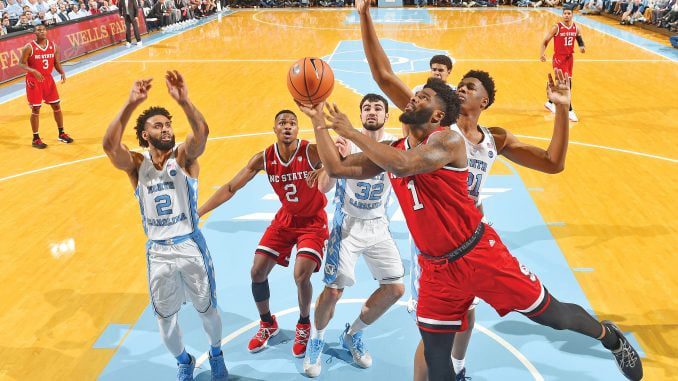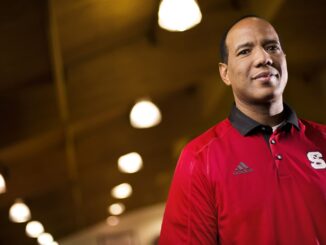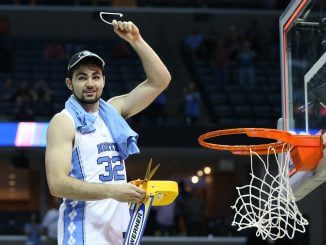
Moments after scoring a career-high 29 points to lift NC State to an overtime win at rival North Carolina on Saturday for its third victory this season against a top-10 opponent, Allerik Freeman was asked if he thinks the Wolfpack is an NCAA tournament team.
It was a question so obvious, he didn’t feel the need to answer.
Instead, he asked a question of his own.
“Why wouldn’t it be?” the graduate transfer guard said.
Going strictly by the eye test, there’s no question that the Wolfpack is worthy of being one of the 68 teams selected into the NCAA tournament field 5½ weeks from now. Its three wins against top-10 opponents also present a strong argument for inclusion.
The problem is, appearance and a few high-profile wins aren’t the only criteria used by the committee that determines which teams get into the final bracket and which are left out.
It’s the reason why despite almost identical records prior to Tuesday’s action, State (15-7, 5-4 ACC) is currently teetering precariously on the NCAA tournament bubble while UNC (16-6, 5-4) is still being penciled in as a four seed by most of those who project such things for a living.
The biggest difference between the teams is the strength of their nonconference schedules.
While the Tar Heels’ slate is ranked as the nation’s third-most difficult, bolstered by games against top-tier opponents Michigan State, Arkansas, Tennessee and Ohio State, the Wolfpack’s 149th-rated schedule is dragged down by the likes of South Carolina State, Bryant, Charleston Southern and Presbyterian. Because all of those teams are ranked lower than 300 in the latest RPI index, they hold little to no weight in the NCAA tournament selection process.
It also doesn’t help matters that State suffered early-season losses to Northern Iowa and UNC Greensboro, the latter coming at home.
Those defeats now seem as though they happened an eternity ago, especially in the context of the improvements the team has made since the start of the ACC season in general and the return from suspension of sophomore guard Markell Johnson specifically. But because of the criteria used by the selection committee, they’re blemishes that can’t completely be covered up.
In retrospect, new coach Kevin Keatts could have helped his team’s tournament chances had he challenged it with some more difficult nonconference tests.
Getting to the postseason, however, was the least of Keatts’ worries at the time in which he put the schedule together. At that point he was more concerned with finding as many wins as possible for a team with a patchwork roster that figured to be in the early stages of a rebuilding effort.
Even after a stunning upset of then-No. 2 Arizona in the opening round of the Battle 4 Atlantis over Thanksgiving weekend, the perception of an overmatched Wolfpack remained unchanged. In fact, it was only enhanced after State lost its first two ACC games at Clemson and Notre Dame by a combined margin of 46 points.
Since then, the Wolfpack has completely altered its narrative. With Omer Yurtseven developing into a dominant big man and Johnson becoming a dynamic playmaker who has helped fellow guards Allerik Freeman and Braxton Beverly become better shooters, State has won five of seven, with three of those victories coming against ranked opponents and two on the road.
“I think these guys are learning how to fight. I think they’re learning how to compete,” Keatts said after Saturday’s win at the Smith Center. “I think our guys understand that if we play together and stay together as a team, we can be successful.”
The good news for the Wolfpack is that with half of the ACC schedule remaining, there are still plenty of opportunities left to continue building on its recent success.
Keatts and his team can take the guesswork out of the equation by finishing strong, knocking off another ranked opponent or two and presenting a resume to the committee that simply can’t be ignored on Selection Sunday.
Not that, at least publicly, State is looking that far into the future.
“I try not to get these guys to concentrate on each individual school in the league,” Keatts said. “We know there are some outstanding programs, Carolina being one. We just talk about being in the race. I try not to get them to focus on the top tier. We just stay the course and try to focus on the next opponent.”

Good wins vs. bad losses, a comparison
UNC and NC State might have similar records, but the schedules they’ve played to get to those records have been anything but the same. Here is a comparison of the two teams and why they’re ranked so disparately by both the human polls and the computers.
Note: Using RPI rankings, Quadrant 1 consists of games against opponents ranked 1-30 at home, 1-50 at neutral sites and 1-75 on the road; Quadrant 2 consists of games against opponents ranked 31-75 at home, 51-100 neutral and 76-135 on the road; Quadrant 3 consists of games against opponents ranked 76-160 at home, 101-200 neutral and 136-240 on the road; Quadrant 4 consists of games against opponents ranked 161-above at home, 201-above neutral and 241-above on the road.



